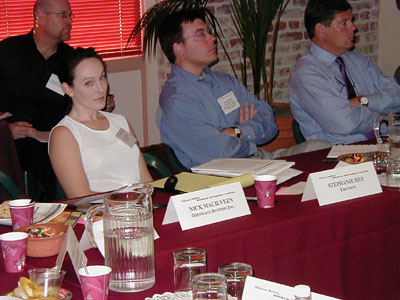
Introduction
The Silicon Valley World Internet Center today held a Think Tank
Session on Mobile Virtual Network Operators or MVNOs. For purposes
of the day’s discussion the definition of MVNO was:
A Mobile Virtual Network Operator is a mobile wireless service
provider of voice and data services that uses or leases capacity
of the wireless communications network of a third-party carrier.
Participanting companies included:
3COM
BAY ANALYTICS
BLACK INK MEDIA
CABLE & WIRELESS USA
COOPETITION, INC.
COWAVE NETWORKS
DAIMLERCHRYSLER RESEARCH & TECHNOLOGY NORTH AMERICA
ERICSSON
ETRIEVE
INTERACTIVE WIRELESS COMPANY
ONWOW
REDKNEE, INC.
RESEARCH|STRATEGY|BUSINESS
SAP
SKY PILOT NETWORK

Summary
Participants identified several market makers and movers for MVNO
models. The group found that highly focused branding and marketing
are key to successful MVNO adoption by the public, along with
understanding of what people want to do with their wireless capability.
They predicted that the first to market will have tremendous advantage
and the best opportunities for revenues through marketing and
sales of products associated with brands such as Virgin, CNN and
MTV. It was also agreed to by several independent consultants
currently working with large telcos in Europe, Asia and the U.S.
that the telcos are committed to the MVNO model. They will make
it happen even if brand names do not pick up the opportunities.
The telcos have crossed the proverbial Rubicon (Julius Ceasar)
in the costly purchases of capacity, especially 3G, and are committed
to recouping those investments. MVNOs provide revenue and cash-flow
models that can sell telco infrastructure capacity. And more than
one MVNO will be selling minutes over a given telco. As customers
move from MVNO to MVNO (from Virgin to MTV, for example) the underlying
telco maintains that customer through the services of the MVNO.
Customer interest in the brand is key.

World Markets
Facilitator Bob Noakes opened the Session by setting expectations
and boundaries.
Although the assumption for the day was that the network infrastructure
for discussion would be 2.5G and 3G, the group touched upon other
networks such as 802.11. They agreed that the large picture of
the ubiquitous development of the wireless space will involve
these other networks, and a device will be able to access any
type of network. For the purposes of the day’s discussion,
however, they agreed to stay with 2.5G and 3G.
Patric Carlsson, principal at Research/Strategy/Business, presented
the group with some of the issues distinguishing the markets in
Europe, Asia and the United States. Carlsson noted that there
are new markets, especially in Asia, with no infrastructure in
place, at all.
In Europe the markets are voice and data. In the U.S. there are
some markets that are data, only. These are represented by companies
such as GoAmerica, Motient, Palm.net and OmniSky. Carlsson emphasised
that U.S. carriers are upgrading their networks. On the East Coast
of the U.S., especially, the infrastructure is built, but the
devices are not yet marketed.

Virgin
Branding and Marketing
Carlsson presented a case study of Virgin Mobile’s activities
in the MVNO space. Virgin has created partnerships around the
world with telcos in several countries to provide the infrastructure
for their MVNO services. The discussion was mainly around Virgin’s
strong branding. Virgin uses the MVNO to push product offerings
from their other business sectors to the market. They also use
the MVNO to push their branding. It was emphasized that Virgin
understands how to focus on their target markets. Virgin knows
the importance of marketing, and their activities are all about
brand everywhere. It was noted that brand loyalty programs in
Britain are so hot that some consumers carry two to three devices
for separate loyalty programs. The watch words for this discussion
were "profile and communicate." Find out what the customer
wants and communicate that to them.

Business versus Consumer
Discussion ensued about U.S. enterprise adoption versus the rampant
consumer adoption in Europe and Asia. While some participants
opined that the big dollars for getting the MVNO concept off the
ground in the U.S. are in the business sector, others argued that
American teenagers have an abundance of discretionary income which
could be available for use in the MVNO arena for branded product
purchases.
The group was in full agreement, however, that the industry is
in its infancy, and that there are blatant indicators of this
in both services and products. Downloads in the form of wireless
advertisements are generally very unsophisticated, hard to read
and do not communicate the message well to the consumer. Also,
telecommunications and data communications have not yet converged
in the psyche of the companies producing devices. They have not
yet marketed the single device to handle all the consumer’s
needs.

Telcos
The group consensus was that telcos are committed to the MVNO
model, with or without independent MVNOs in the market. They have
spent too much money on licensing and infrastructure to leave
the market to chance. If the MVNOs don’t do the job, the
telcos will develop their own market-brand portals for selling
product, as Telia has done in Sweden. But the telcos must subvert
their brand to the brand of the MVNO. Will they do it? The group
agreed that they will, indeed, give up brand position for revenue.
The customer wants services; they don’t care about how they
are delivered. Just as imode never mentions the Internet, Virgin
will never bother the consumer with the fact that it leases capacity
from One2One, which is owned by Deutsche Telekom. After all, the
first question one asks when another person answers the mobile
phone is, "Where are you?" not "Who’s your
carrier?"

Business Models
The group suggested several ideas that could be successful elements
of business models for the MVNO space. The list follows.
• Sponsored services subsidized by brands
• Single device that can access all applications. Carriers
will leverage their infrastructure for profit mod
• One that "splits the pie" fairly and safely
• Access to desktop applications such as email
• Vertical market opportunities include
• Field services support
• Sales support for mobile users
• Access for specific vendor applications such as Oracle,
SAP & Sybold
• Bell Curve thesis
Within the next 24 to 48 months, the curve will rise on proliferation
and fall on consolidation. If this proves true then:
• There may be a limited term opportunity to set up a business
as a provider of custom MVNOs
• They may be near term business opportunities in the enabling
space for MVNOs
• The long term prospect may suggest that the carriers should
focus more energy on this opportunity
• Hands-free mobile telephony – most Americans access
their mobile phones in the car
• Loyalty programs w/MOUs as the currency for use of the
phone and accompanying credit card. Bill and rewards come from
one brand/bill
• MVNO is a VAR that owns a customer’s customer base.
It will sell services from multi-types of networks run by multi-operators
• Focus on and understand WHO your customer is and what he/she
wants. THEN adapt your service offering
• Free phones
• Short messaging services (SMS)
• Location-based
• Info-entertainment
• Co-branding
• VAR Services
• Two- and three-tier delivery model which was very unsuccessful
for DSL wholesalers may apply here
• Group data content for each specific "Interest Group,"
and bundle adequate (price, volume) plan with it into a package.
Focus on the "identity and psyche" of the group
• Ability to spread customer acquisition cost & relationship
management cost across multiple "product/service" areas
• Multichannel consumer – Example: Geneva & Virgin
• Hybrid – Example: Nokia
• UPN Analog – Example: Enterprise Defense
• Panisitic – Example: Nomadic, HighlyTuned, 3Com Park

Key
Enablers
The group also provided the Center with ideas for key enablers
for the MVNO market over the next 12 to 18 months. Those included:
• Pre-paid data, such as short messaging service
• Carriers change their attitude that they must own the customer
relationship
• Mobile data applications offered from other Internet applications
will allow carriers to sit between customers and their information
• MiddleWare: API Gateway interface between desktop application
and mobile devices such as PDA, cell, pager
• Bandwidth Technologies – new ways to utilize bandwidth
to deliver rich content without the need for 3G infrastructure.
• New devices & products for Push --- Pull
• Marketing / Lifestyle message (Nike, AOL, Microsoft)
• Infrastructure
• Proliferation of network-enabled devices
•Roaming & Billing & other support services
• Providing people with ability to attach one identity to
all services and devices
• Excess capacity from carriers
• Brand owners participation
• Ability to provide more value added data services that
the carriers can. Will show unique value
• Push
• Location (GPS, Enhanced 911)
• Receiving & storing data while "off"
• Low-cost barrier to entry. Phones are still very expensive
when you add all of the accessories. Larger subsidies to kickstart
the market
• Strong, competitive wholesalers of the communications infrastructure,
analogous to what generic eCommerce back ends offered to retailers
• Improved user interface methods to interact with a device
in a digitized way
• Privately sharable location-based servicesBarriers to MVNO
Adoption

Barriers
The participants were also asked to identify what they
considered to be barriers to the success of the MVNO model in
the next 12 to 18 months. These included:
• The control mentality of the carriers
• The lack of network and device capabilities
• Lack of a Killer Application
• U.S. networks are not compatible with one another
• Build out of U.S. infrastructure for 3G
• Allocation of frequency, specifically, military use and
application in the range that business and enterprise needs
• Meeting consumer expectations of acceptable performance
and customer intimacy in a cost-effective way
• Cost
• Technology
• Quality of Service
• Lack of better functioning connectivity will help get people
to use wireless communications more in the U.S.
• Competing U.S. standards / lack of standards for bridging
communications across a hybrid of carrier networks
• Wireless coverage
• MNO & MVNO 50/50 models assume brands are constant.
Impacts flexibility of VNO brand to move
• Technology-driven mind sets and solutions
• Ability of an MVNO to reach a significant market size based
on their "affinity" factor for brand-driven customer
acquisition

Last But Not Least
Last but not least, Noakes asked participants to give him one
word that is key to MVNO adoption. The results are below with
an asterisk for each vote that concept received from the group.
• Brand **********
• Profitable
• Speed
• Applications **
• Focus
• Services **
• Standards
• Identity *****
• Access
• Cash Flow
• Churn
• ARPU (Average Revenue Per User) **
• Syndication **
• Revenue **
• Loyalty *
• Leverage













